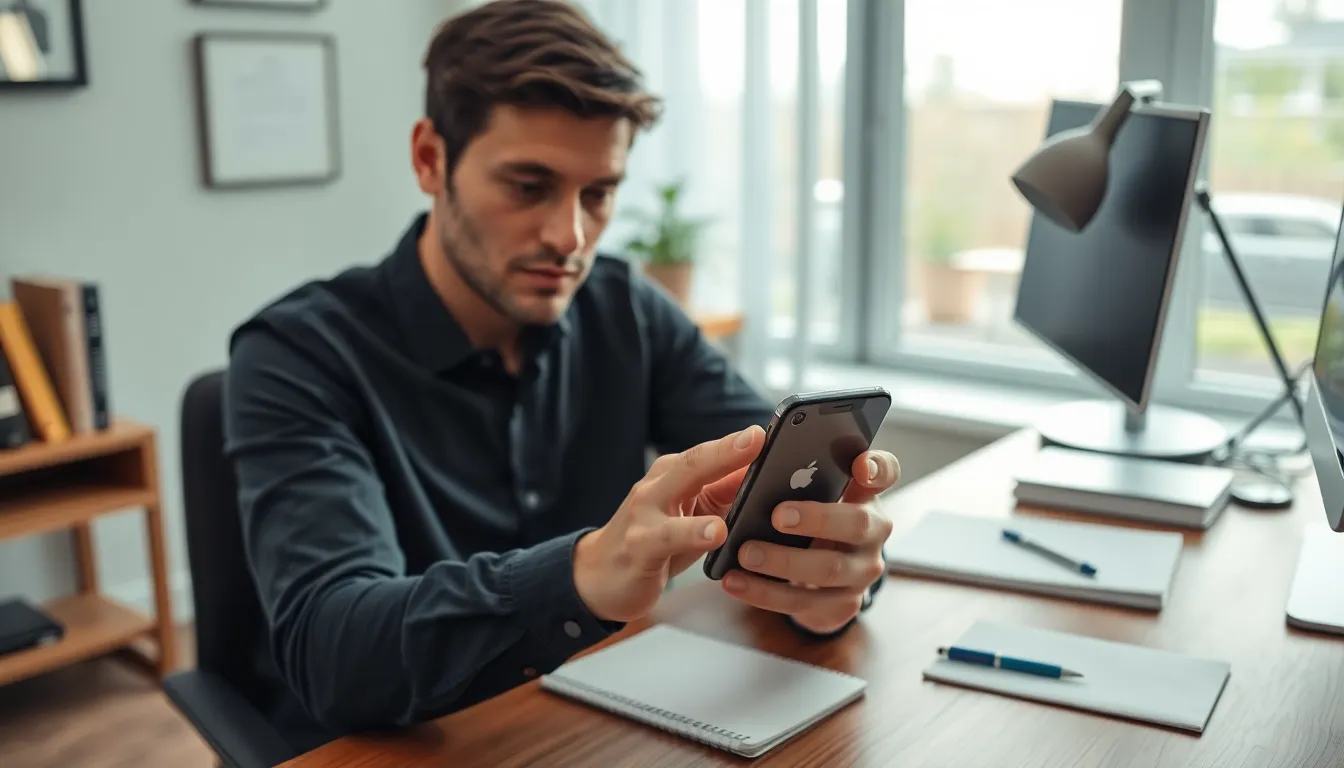In a world where every word counts, capturing those golden nuggets of conversation can be a game-changer. Whether it’s a crucial business meeting or a heart-to-heart with a friend, knowing how to record a conversation on an iPhone can save the day. Imagine never having to rely on your memory again—it’s like having a personal assistant right in your pocket!
Table of Contents
ToggleUnderstanding the Need for Recording Conversations
Recording conversations serves multiple purposes across different contexts. In business settings, it captures critical information from meetings, ensuring no details get overlooked. Participants find it useful for referencing discussions later, improving communication efficiency.
Legal situations also benefit from recorded exchanges. Having an accurate account of conversations may provide valuable evidence, protecting rights and clarifying agreements. Many individuals rely on recordings to resolve disputes or confirm understandings.
In personal contexts, recording important talks helps preserve cherished memories. Friends and family can reflect on meaningful conversations and maintain stronger connections. Enhanced recall of discussions fosters deeper relationships, especially during significant life events.
Often, recording conversations reduces anxiety over forgetting critical points. The assurance of having a documented source alleviates pressure during negotiations and decision-making. Clarity in communication encourages openness and honesty among participants.
Studies suggest that listening to recorded exchanges improves comprehension. Individuals can evaluate their discussion techniques and identify areas for growth. This practice promotes better interpersonal skills over time.
Some regions may have specific legal requirements regarding consent for recording conversations. Understanding these laws is essential to ensure compliance and avoid potential legal repercussions. Being well-informed about local regulations plays a significant role in the decision to record.
Ultimately, the ability to record conversations on an iPhone offers convenience and reliability. This feature equips users with tools for effective communication in various scenarios. Whether for business, legal, or personal reasons, recording conversations can enhance understanding and preserve vital information.
How to Record a Conversation on iPhone

Recording conversations on an iPhone is straightforward and convenient. Users can choose from built-in tools and third-party applications.
Using the Voice Memos App
The Voice Memos app comes pre-installed on iPhones, making it easily accessible. To begin, open the app and tap the red record button to start capturing audio. Users can pause and resume the recording as needed. After speaking, stopping the recording saves the file automatically. It’s possible to name files for easy organization. To share recordings, tap the memo, select the share icon, and choose a preferred sharing method. This app provides clear sound quality, suitable for most recording needs.
Third-Party Apps for Recording
Numerous third-party apps offer advanced recording features. Apps such as Rev Voice Recorder and Otter.ai provide enhanced functionality like transcription services. User-friendliness and additional features can vary significantly. Most of these apps enable users to record directly from their devices and offer cloud storage options. To utilize these apps, users must download them from the App Store. Exploring different ratings and features aids in selecting the best app for specific requirements. Many options also include editing tools, simplifying the process of creating clear recordings for later use.
Legal Considerations for Recording Conversations
Recording conversations involves various legal considerations. In many jurisdictions, laws vary between one-party and two-party consent. One-party consent means only one participant in the conversation must agree to the recording. In contrast, two-party consent requires that all participants provide their approval.
Many states in the U.S. follow a one-party consent rule. For example, Texas and New York permit recordings without informing other parties, as long as one party consents. On the other hand, states like California and Florida enforce two-party consent, making it illegal to record someone without their knowledge and agreement.
Consulting local laws is crucial before recording any conversation. Ignoring regulations can lead to severe penalties, including fines or criminal charges. Additionally, workplace policies may impose stricter guidelines around recording conversations, regardless of state laws.
Legal exceptions exist for certain contexts. Law enforcement officers often record conversations during investigations, usually with a warrant or consent. Journalist interviews may also allow recordings under specific conditions, but transparency remains essential.
Moreover, ethical considerations accompany legal factors. Informing participants about the recording fosters trust and encourages open dialogue. Transparency can significantly enhance professional and personal relationships.
Individuals using iPhones to record conversations must prioritize understanding these legal nuances. Seeking legal advice can offer specific guidance regarding recording conversations in various scenarios. Ultimately, respecting consent and following laws safeguards everyone’s rights while promoting effective communication.
Tips for Successful Recording
Choose a quiet environment for recording conversations. Minimizing background noise ensures clearer audio quality. Adjust the iPhone’s microphone settings as needed to enhance pick-up capability.
Position the device near the speakers. This enhances capture quality, leading to better recordings. Check battery levels before starting to avoid interruptions during important exchanges.
Test the recording functionality in advance. Verifying the app’s performance assures readiness. Consider using a headset with a microphone for improved clarity, especially in noisy surroundings.
Organize recordings immediately after capturing them. Labeling files with relevant details such as the date and context aids future retrieval. Share recordings with participants promptly to confirm accuracy and understanding.
Review legal requirements for each recording session. Knowing local laws regarding consent prevents legal complications. Maintaining transparency with participants fosters trust and promotes open dialogue.
Experiment with different recording apps to find the optimal fit. Some apps offer features such as transcription or easy cloud storage. Reading user reviews can help identify apps that align with specific needs.
Practice active listening during discussions while recording. This enhances engagement and increases the likelihood of capturing important points. Stay focused on the conversation, allowing for organic dialogue flow.
Utilize organizational tools on the iPhone for easy access. Storing recordings in dedicated folders simplifies future searches. Regularly backing up recordings ensures they remain safe and accessible.
Recording conversations on an iPhone can significantly enhance communication and understanding in both personal and professional contexts. By leveraging the built-in Voice Memos app or exploring third-party options, users can effortlessly capture important discussions.
It’s crucial to remain aware of legal requirements and prioritize consent to ensure ethical practices. With thoughtful preparation and attention to detail, individuals can create a reliable record of conversations that not only preserves memories but also fosters trust and clarity among participants. Embracing these tools and techniques can lead to more effective interactions and improved relationships in various aspects of life.


